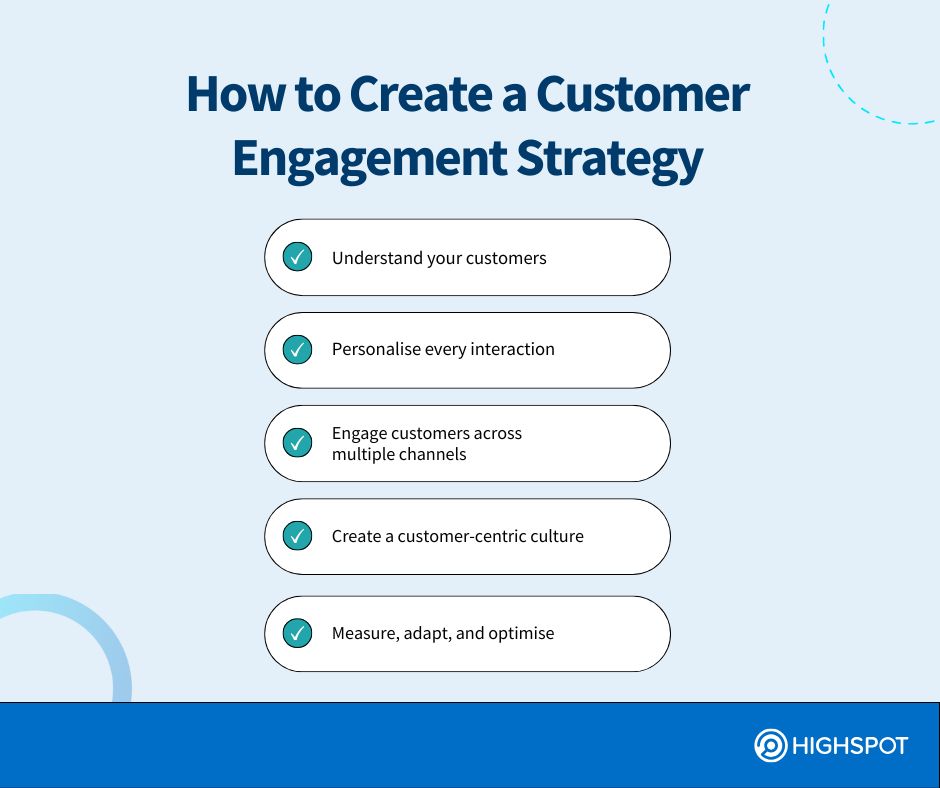Key Takeaways
- Brands prioritising customer experience throughout the lifecycle see retention rates increase by up to 60%.
- A well-defined customer engagement strategy helps build meaningful, long-term relationships.
- Engagement is a two-way street—listening to and acting on customer feedback creates a sense of partnership and reciprocity.
Businesses across all industries are talking about customer engagement—but is it just a buzzword, or does it deliver real value? The answer is easy: it works. Without engaging your customers, you risk losing deals, eroding trust, and becoming merely transactional, which won’t work for most businesses.
Humans crave connection. We need answers, reassurance, and the ability to put a face to the products or services we rely on, especially when the stakes (and costs) are high. Whether it’s a major purchase that could put our careers on the line or a simple decision to try something new, engagement makes all the difference. Companies with a well-defined sales methodology and customer engagement plan that prioritises customer experience throughout the entire lifecycle reap measurable retention, customer loyalty, and revenue growth results.
According to Gartner, retaining and selling to existing customers is more cost-effective and profitable than acquiring new customers. By creating exceptional brand experiences, businesses reduce customer churn and develop a loyal customer base that is more likely to stay and advocate for your brand.
The good news is that building a meaningful customer engagement strategy doesn’t have to be complicated. You can foster deeper connections and build long-term reciprocal relationships with a few focused steps.
What is a Customer Engagement Strategy?
A customer engagement strategy is a plan to capture your audience’s attention and build relationships far beyond the transaction. It creates informational, emotional, and behavioural connections at every touchpoint. At peak engagement, you strengthen bonds with first-time contacts and loyal customers seeking more product value.
For example, a new prospect might discover your brand through a marketing campaign ad highlighting a problem they face, leading them to a whitepaper that explains your solution. On the other hand, existing customers will engage with your customer success or customer support team during regular check-ins. If successful, they might identify a need for a case study or a referral to industry peers to discuss expanding product use.
Effective customer engagement strategies are multi-dimensional and can be measured by the time, energy, and effort a customer invests in your brand, reflecting their loyalty.
Why is a Customer Engagement Strategy Important for Your Business?
Customer engagement is more than a temporary initiative; it’s critical to business success in any industry, from manufacturing and e-commerce to finance and enterprise. No matter the sector, the benefits are apparent when you value strong human relationships.
Engaged customers tend to buy more, remain loyal for longer, and recommend your brand to others. It’s as simple as that. Engagement is being present, listening, and showing you care; the results speak for themselves.
- Improves retention and reduces churn: Existing and potential customers need to know you’re invested in their success and will not disappear after the initial sale is closed. In many cases, their job or business might depend on your product’s continued performance. For example, Bain & Company highlighted a manufacturer implementing engagement initiatives throughout the user experience. These efforts increased customer retention from 35% to 60%, nearly doubling their retention rate.
- Boosts conversions and customer lifetime value: Engaged customers are likelier to make repeat purchases and become long-term brand advocates. Studies show that strategies focused on delighting customers allow companies to earn greater value from their current customer base, resulting in concrete financial outcomes.
- Builds trust and advocacy: Word of mouth is priceless; nothing builds trust better than presence. Whether you’re selling a toaster, a new cell phone, or a half-a-million-dollar software solution, customer reviews are often the deciding factor, especially in competitive markets. Advocate stories validate your brand’s promise and are often more influential than any advertising you can produce.
How to Create a Winning Customer Engagement Strategy
Building a strong customer engagement strategy might initially feel daunting, but breaking it into manageable, actionable steps makes it achievable. Here’s how to start:

Step 1: Understand Your Customers
A meaningful customer enablement strategy starts with positive emotional understanding and customer connections. You have to know what makes them tick. This goes beyond online LinkedIn research or surveys; it means genuinely understanding what they value most.
- Talk to your customers: There’s no substitute for honest conversations. Interviewing customers lets you ask about their demographics, interests, buying habits, and preferred engagement.
- Use data to uncover patterns: Collect data from every interaction, interview, survey, social media post, and general research. Also, ask for customer reviews and read them. Your best information will come from quantitative and qualitative customer feedback. Track and analyse this feedback for improvement, trends, preferences, pain points, and customer behaviour.
- Leverage CRM tools: A good CRM solution helps you organise and track customer interaction information, making it easier to make everything personalised and timely throughout the customer journey.
Step 2: Personalise Every Interaction
No two customers are the same. They might come from different industries or regions or have unique needs, even if they solve the same problem with your product. Personalisation shows you understand their challenges and care about their success.
- Segment your target audience: Group customers by industry, maturity, or specific pain points. For example, a startup struggling with its first processes will need a different approach than an enterprise focusing on scale.
- Tailor your messaging: Use what you know from previous research or use templates to create personalised email campaigns, recommend products based on prior purchases, or proactively offer upsells. Customers who feel personally understood by a brand are more likely to develop an emotional connection, leading to higher engagement.
- Use AI to scale personalisation: AI and automation can help you scale personalised experiences while keeping them authentic. Imagine two customers evaluating the same software. One is trying to minimise manual work, while another is trying to demonstrate future ROI. These needs are distinct and require tailored messaging and supporting content. AI can help to pinpoint these nuances quickly, find relevant content, and formulate appropriate messages. Read more about accelerating sales efficiency with AI in The State of Sales Enablement Report 2024.
Step 3: Engage Customers Across Multiple Channels
Today’s customers expect fast, flexible communications on their terms. Some prefer email, others want quick texts, and many continuously move between channels. That said, it’s essential to maintain consistent messaging and branding across all communication channels.
- Build an omnichannel plan: This includes email, chat, social media platforms, and even in-person interactions. There’s nothing worse than a disconnected experience where customers feel like they’re starting over every time they reach out. Engagement is often most successful when customers experience consistency across all channels. Be sure all touchpoints flow and are integrated, tracked, and accessible across teams.
- Implement digital sales rooms: Digital sales rooms (DSRs) provide a centralised space for sharing personalised content, webinars, proposals, pricing, and other data with buyers. These virtual hubs allow customers to engage with your sales materials at their convenience.
- Be where your customers are: Make your brand stand out everywhere your customers do business. For example, boost your social media presence with interesting posts and quick replies. If you post a stat on social media that gets little attention but a video of a customer success story sparks a lot of engagement, you’ve found what resonates with your customer base.
- Start a customer loyalty programme: Show your customers some love with exclusive benefits, incentives, discounts, or early access to new products. A good loyalty programme keeps your best customers coming back, strengthens their connection to your brand, and helps you understand what they really want. Plus, when customers feel valued, they’re more likely to spread the word and bring in even more business.
- Stay responsive: Buyers today expect immediacy. If they can get groceries in hours and packages overnight, they’ll expect the same from you regardless of platform. You may even get DMs on social media with questions and new buyer opportunities. Responsiveness is critical, so don’t forget to monitor it!
Step 4: Create a Customer-Centric Culture
Engaging customers does require processes, careful planning, and tools, but most importantly, it involves people. Every customer-facing team member must adopt a customer-first mindset, starting with effective sales onboarding. That is the only way it will work.
- Eliminate silos: Teams need to communicate. When the sales process ends, it should transition smoothly to customer success without missing a beat. Customers prefer to avoid repeating details already shared with the AI bot when a human picks up. If it doesn’t integrate and work smoothly, stop using it.
- Equip your teams: Your tech stack should help your team facilitate interactions with solutions such as chatbots, live chat, survey tools, social listening platforms, and analytics for real-time insights. Additionally, leverage sales enablement tools, CRM systems, AI, and content management systems to track customer data, access resources, and personalise interactions. With the right tools, your team can significantly enhance customer relationships and drive engagement.
- Train and coach regularly: Offer in-person and online training sessions to update your team on the latest messaging, product updates, and sales engagement strategies. That way, they can adapt to changing customer needs and provide value in every interaction.
- Commit as a company: Everyone, from leadership to every customer-facing team, should share a commitment that every interaction delivers value and strengthens customer success. Their success is your success.
Step 5: Measure, Adapt, and Optimise
A winning customer engagement strategy isn’t static—it evolves based on data, feedback, and performance. Regularly measuring helps uncover friction points to help you refine your approach for long-term success.
- Identify engagement metrics: Customer engagement metrics offer a clear lens into how customers interact with your brand at every stage of their journey. Monitor metrics like retention rates, net promoter scores (NPS), customer satisfaction (CSAT) conversion rates, and social engagement to understand what’s working and where adjustments are needed.
- Gather and incorporate customer feedback: Collect feedback through surveys, reviews, and direct conversations to uncover areas for improvement and identify barriers to purchasing or engagement. Be sure to respond to this feedback through improvements and acknowledgement.
- Refine your strategy: Use the data you’ve collected to iterate on your approach, aligning your efforts with evolving customer needs, market trends, and performance gaps. This ongoing practice will enable you to develop dynamic, customer-centric experiences. For example, if the customer average session duration is high, your customers are likely finding your content engaging. However, if the bounce rate is high, you might want to reevaluate the value of your content and potential roadblocks customers might encounter. Additionally, incorporate these insights into your sales training programme to ensure your team is equipped to address these gaps and improve customer interactions.
Supercharge Your Customer Engagement Strategy
Fierce competition, economic shifts, and new tech come with industry opportunities and threats. Because of this, customer expectations are higher than they have ever been, and that is not going to change. Today’s customers expect a product that adds value to their daily lives and a company that cares about and understands them. Meeting—and exceeding—these expectations requires businesses to prioritise customer engagement, no matter what they’re selling.
Highspot’s sales enablement tool arms customer-facing teams with the best sales coaching, training, and communication tools to personalise engagement and connect with customers across multiple channels at the right time.




